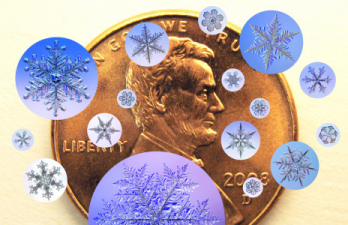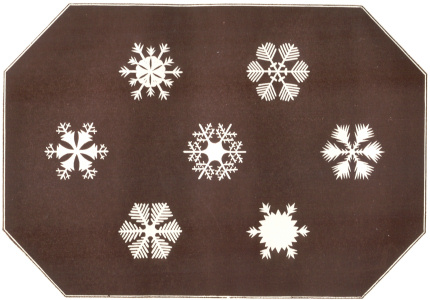|
| See also the Guide to Snowflakes, and my Snowflake Science Primer. |
|

Snowflake Sizes
The smallest snowflakes are called Diamond Dust crystals,
and they might be as small as the diameter of a human hair. The faceted
crystals sparkle in sunlight as they float through the air, which is
how they got their name. They are somewhat rare, appearing in bitter
cold weather.
The image on the left shows the sizes of a variety of stellar snowflakes when compared to a penny. It includes the largest snow crystal ever photographed, measuring 10 mm (0.4 inches) from tip to tip. |
| 
By the Numbers
About
a million billion snowflakes fall each second, averaged over a typical year. That's enough snow to
make one snowman for every person on earth every ten minutes. (Of
course, this is quite a rough estimate. The amount of total snowfall each
year is not known well, nor is the average size of a snowflake.)
|
|  Seen Snow? Seen Snow?
Recent estimates
suggest that about half of the world's population has never seen snow
close up. Most of China experiences some snowfall, but most of India
and Indonesia do not. The equatorial regions of South America, Africa,
as well as the desert regions of the Middle East, see the least snow on
earth. |
| 
Frozen
About
98% of the Earth's water is in the oceans, leaving 2% as fresh water.
About 90% of that fresh water is permanently frozen, mostly locked up in
the Antarctic and Greenland ice sheets. |
|  Early Paper Snowflakes Early Paper Snowflakes
Frances
Chickering, a minister’s wife from Maine, published
these snow-crystal images along with many others in her 1864 book Cloud Crystals: A Snow-Flake Album.
She examined snow crystals as they fell on her windowsill and quickly
cut paper replicas of their forms, which were later transferred to the
pages of her album. Ms. Chickering could hardly have imagined that the
craft she was pioneering would later be practiced by millions of school
children around the world.
|
|
|
|
